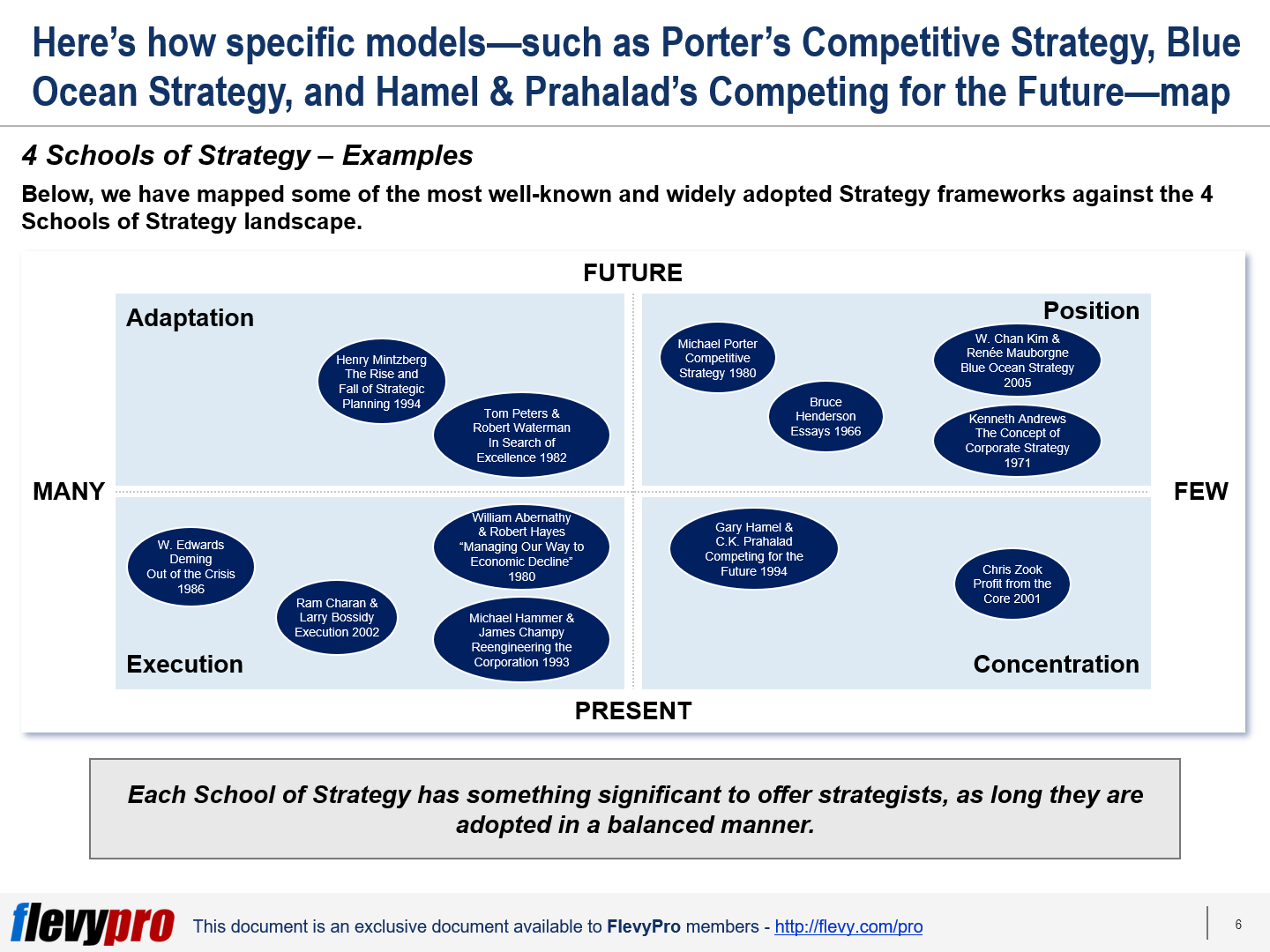Editor's Note: Take a look at our featured best practice, Complete Guide to Business Strategy Design (51-slide PowerPoint presentation). Summary: This document provides a framework to design your business strategy.
A key question that every business needs to able to answer is "What is our strategy?"
'Strategy' is part of everyday business language and is often used in the wrong context (e.g. 'Operational Excellence' is not [read more]
Also, if you are interested in becoming an expert on Strategy Development, take a look at Flevy's Strategy Development Frameworks offering here. This is a curated collection of best practice frameworks based on the thought leadership of leading consulting firms, academics, and recognized subject matter experts. By learning and applying these concepts, you can you stay ahead of the curve. Full details here.
* * * *

Over the years, countless business frameworks on Corporate and Business Strategy have been developed. We can categorize these frameworks into 4 schools of thought.
Let’s call them the 4 Schools of Strategy, which are:
- The Position School
- The Execution School
- The Adaption School
- The Concentration School
We can represent these 4 schools on a 2×2 matrix, depicted below on the slide.
On this 2×2, we have also mapped some of the most well-known and widely adopted Strategy frameworks against the 4 Schools of Strategy landscape.

On this 2×2, the x-axis represents the point of view on authorship. This dimension addresses the question of who is responsible for major strategy decisions. At the left (many) are those who favor collective choice. In other words, strategic thinking is installed among as many people throughout the organization as possible. At the right (few) are those who favor top-down formulation. In other words, Strategy is developed by the few—the designated expert planners and senior executives—while the rest of the organization is dedicated to execution of the Strategy.
 The y-axis represents time orientation. At the top (future), we have those who favor moving toward a long-term destination that may be different from the organization’s current position. At the opposite end (present), we have those who favor letting the organization’s strategic direction emerge from its current state.
The y-axis represents time orientation. At the top (future), we have those who favor moving toward a long-term destination that may be different from the organization’s current position. At the opposite end (present), we have those who favor letting the organization’s strategic direction emerge from its current state.
It is actually common for organizations to rotate from one School of Strategy to another over time.
Now, let’s define each School of Strategy in further depth.
The Position School
The idea of Strategic Planning began to take form in the 1960s, driven by an increased availability of data (e.g. costs, prices, performance metrics) and economic uncertainty.
From the process of Strategic Planning, a Strategy was developed. This was an overarching plan for growth, usually formalized in a business document and endorsed by the CEO. This Strategy Plan aimed at creating a dominant, unassailable market position for the organization in the market.
These early efforts by the “Position School” believed successful Strategy emerged through the comprehensive analysis of all critical factors:
- External markets
- Internal capabilities
- Customer and societal needs
This typically, a SWOT exercise is conducted as part of the Strategic Planning session.
A breakthrough in the Position School was driven by the advent of Bruce Henderson’s BCG Experience Curve, which also led to the creation of the BCG Growth-Share Matrix. Michael Porter later brought the Position School to a level of unprecedented sophistication through his Porter’s Five Forces and Porter’s Value Chain frameworks. A more modern framework still under the Position School is Blue Ocean Strategy.
The Execution School
The Execution School is founded on the belief that organizations should focus on Execution and Operational Excellence—i.e. an internal focus, instead of external, as the case of the Position School.
Operational Excellence is tied closely to operations-focused management philosophies of Six Sigma and Lean Management. The underlying focus is Continuous Improvement throughout the organization by focusing on the needs of the customer, empowering employees, and optimizing existing activities in the process.
The Adaption School
The Adaption (and Experimentation) School emerged in the 1990s through the thought leadership of Henry Mintzberg. Mintzberg’s strategic approach focused on discovering a more creative, experimental approach to decision making. The thesis is to achieve results through acting quickly and creatively in response to events.
The management focus here is Organizational Learning.
The Concentration School
The fourth school of thought, Concentration School, argued that the most effective strategy is to foster a set of Core Competencies.
Per Gary Hamel and C.K. Prahalad, organizations should focus on their Core Competencies and use them to develop a long-range Strategic Intent. Capabilities-Driven Strategy (CDS) is a modern Strategy framework also based on a similar premise of fostering sustainable Core Capabilities to develop a Competitive Advantage.
Interested in a deeper dive into these Schools of Strategy? Take a look at our framework presentation, the 4 Schools of Strategy, which is part of the FlevyPro Library.

153-slide PowerPoint presentation
[NOTE: Our Hoshin Kanri presentation has been trusted by an array of prestigious organizations, including industry leaders such as Apple, Facebook, Boeing, Shell, Goodyear, Cummins, Johnson Controls, Hanes, Telefónica, Chubb, Discover, Stryker, Thales, Saint-Gobain, AGCO, to name just a
[read more]
Want to Achieve Excellence in Strategy Development?
Gain the knowledge and develop the expertise to become an expert in Strategy Development. Our frameworks are based on the thought leadership of leading consulting firms, academics, and recognized subject matter experts. Click here for full details.
"Strategy without Tactics is the slowest route to victory. Tactics without Strategy is the noise before defeat." - Sun Tzu
For effective Strategy Development and Strategic Planning, we must master both Strategy and Tactics. Our frameworks cover all phases of Strategy, from Strategy Design and Formulation to Strategy Deployment and Execution; as well as all levels of Strategy, from Corporate Strategy to Business Strategy to "Tactical" Strategy. Many of these methodologies are authored by global strategy consulting firms and have been successfully implemented at their Fortune 100 client organizations.
These frameworks include Porter's Five Forces, BCG Growth-Share Matrix, Greiner's Growth Model, Capabilities-driven Strategy (CDS), Business Model Innovation (BMI), Value Chain Analysis (VCA), Endgame Niche Strategies, Value Patterns, Integrated Strategy Model for Value Creation, Scenario Planning, to name a few.
Learn about our Strategy Development Best Practice Frameworks here.
Readers of This Article Are Interested in These Resources

23-slide PowerPoint presentation
Strategic Planning is an essential tool for organizations aiming to thrive in today's dynamic business environment. It's not just about setting goals--it's also about crafting a roadmap for sustainable success. For executives, understanding and effectively implementing Strategic Planning is crucial
[read more]

144-slide PowerPoint presentation
Frameworks are powerful tools Strategy Consultants leverage to address their clients' business issues in an organized, thorough, and efficient fashion.
In this presentation, we provide primers to 20 consulting frameworks used by Strategy Consulting firms. These frameworks have been categorized
[read more]

48-slide PowerPoint presentation
Most frameworks, guides, and business gurus that discuss corporate strategy focus purely on the theory of great strategy, but don't teach the art of great execution. Without execution, strategy is merely theory.
In fact, a common complaint of strategy consulting firms is that they leave clients
[read more]

62-slide PowerPoint presentation
The Strategy Chessboard is a holistic Strategy Development framework developed by A.T. Kearney. It first presents a 2X2 of 4 Umbrella Strategies:
1. Position and Conquer (e.g. Porter's Five Forces, Profit Patterns, Art of War)
2. Redefine the Industry (e.g. Consolidation Curve, Value Chain
[read more]


 The y-axis represents time orientation. At the top (future), we have those who favor moving toward a long-term destination that may be different from the organization’s current position. At the opposite end (present), we have those who favor letting the organization’s strategic direction emerge from its current state.
The y-axis represents time orientation. At the top (future), we have those who favor moving toward a long-term destination that may be different from the organization’s current position. At the opposite end (present), we have those who favor letting the organization’s strategic direction emerge from its current state.



